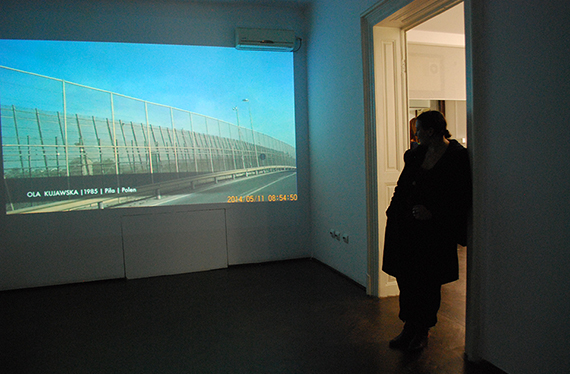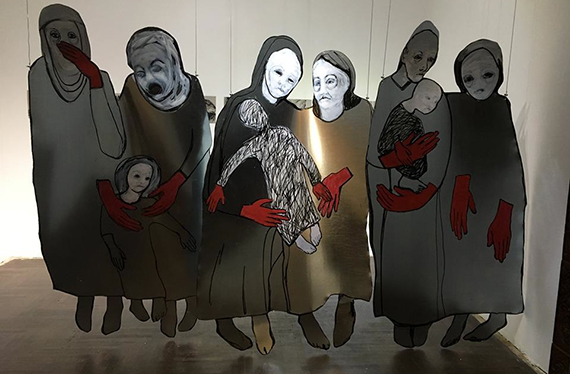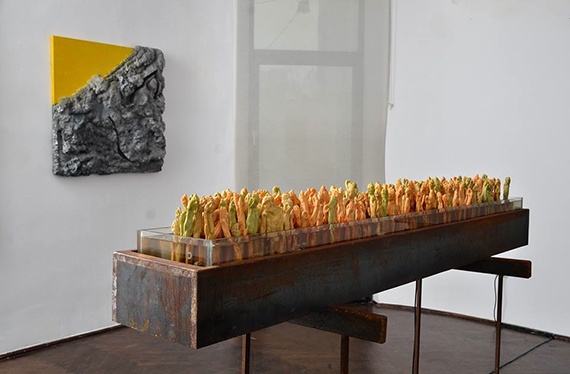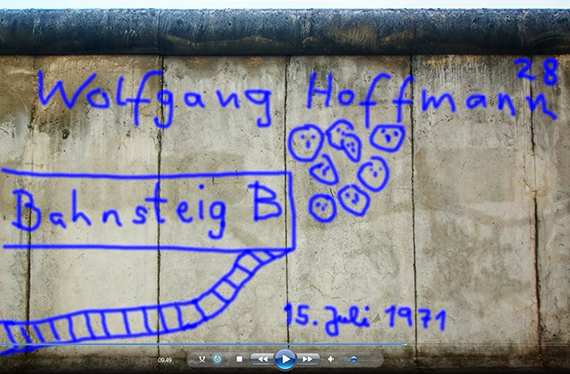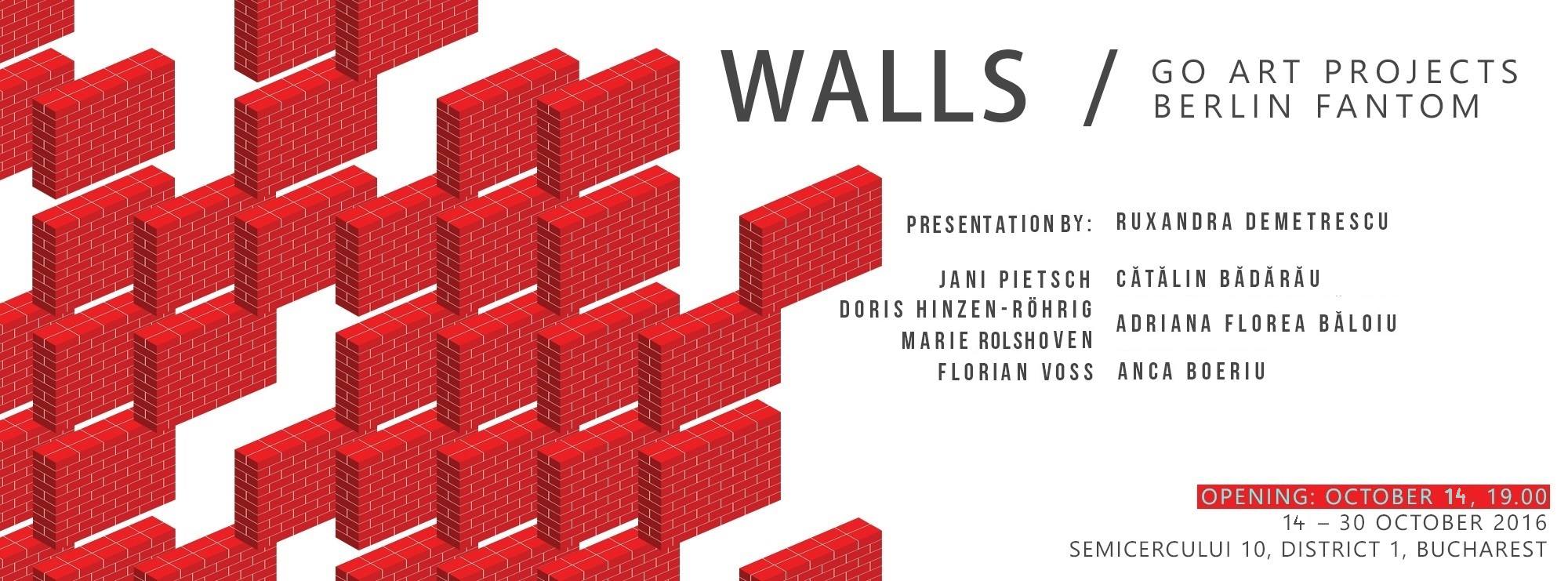
WALLS
GO ARTS PROJECTS BUCHAREST
Presentation by: Ruxandra Demetrescu
Jani Pietsch | Doris Hinzen-Röhrig | Marie Rolshoven | Florian Voss | Cătălin Bădărău | Adriana Florea Băloiu | Anca Boeriu
On allait coller un homme contre un mur et lui tirer dessus jusqu’à ce qu’il crève…
(Jean-Paul Sartre, Le mur)
The project hosted by Go Contemporary gallery presents the results of an innovative collaboration
between Go Art Projects (a platform for contemporary art) and Fantom Berlin - Netzwerk für Kunst und Geschite(n):
three Romanian artists (Adriana Florea Băloiu, Anca Boeriu and Cătălin Bădărău)
communicate with four German authors (Jani Pietsch, Marie Rolshoven, Florian Voss and Doris Hinzen-Röhrig) in an attempt
to identify a visual theme for the profound, plurivocal meanings of the walls. Because the wall has been regarded as a dramatic
obstacle, which separates, delimitates and excludes, as a mark for borders (The Berlin Wall) and death
(the wall of execution from Sartre’s short story). But apart from all that, a wall bears the visible signs of time,
becoming a privileged witness of recent history.
The exhibition called Ziduri (Walls) faces the beholder with distinctive
points of view and conceptual marks, visually configured through settings coming from different areas
(painting, sculpture, object, photography, video and sound).
In Adriana Băloiu’s illusions (Illusion) the wall becomes an
excuse for evasion (“the walls, the borders, the limits of human inside or outside existence... are there, here, everywhere.
We know that. But what can we do best with this piece of information is to ignore it, to close our eyes and imagine a dream scenery”).
On the contrary, for Anca Boeriu the wall is a concrete reality
(built by monumental characters - women and children –, cut in a zinked chalkboard,
on which she adds drawings and color), but also a metaphor for exile (imagined in the exhibition through a wall on which there are shown monotypes
of the immigrant women).
In Derail, Cătălin Bădărău created a wall by crowding so many characters that it becomes an almost shapeless mass,
suggesting the drift of humankind.
Compared to the more or less metaphysical dimension proposed by the Romanian artists,
the German authors have chosen to fairly fructify some emblematic moments of recent history. Therefore, the Eingesperrt_Ausgesperrt (Locked In_Locked Out),
presented two years ago in Fantom gallery in Berlin, creates a dialogue among several historical episodes that thematize the wall
as a border and symbol of exclusion, exile and – in extremis – of death. The video installation created by Marie Rolshoven and
Florian Voss remembers the 136 victims of the Berlin Wall, visually inspired by the research work of historians like Hans-Hermann
Hertle and Maria Nooke, published in the volume entitled Die Todesopfer an der Berliner Mauer 1961-1989. The two authors virtually
reconstructed the Berlin Wall, projecting on its image, as it was, graffiti drawings that suggest or narrate, with words and ideograms,
the history of the victims, as it has never been written on the real wall, which was demolished after 1990.
Jani Pietsch has covered in Ausgesperrt aus Europa the filmed image of a wall made of barbed wire
(the one that separated the Spanish enclave Melilla in Morocco, as the extreme Southern border of Europe)
with loud recordings in four languages (testimonies of immigrants belonging to different generations and areas,
forced to choose a life in exile as the only form of survival).
For Doris Hinzen-Röhrig the wall seems to be a visible witness of history, developed in a series of photographs
on which the artist intervened with pictorial elements.
The pathway created by the exhibition eventually determines the beholder
to make a necessary exercise to remember a common recent history, in order to fight against the inevitable temptation of forgetting.
Ruxandra Demetrescu
11 October 2016
WALLS
GO ART PROJECTS BERLIN FANTOM
Opening: 14. October, 19 h
Str. Semicercului, Nr. 10
Sector 1
Bucharest
14. - 30. 10.2016
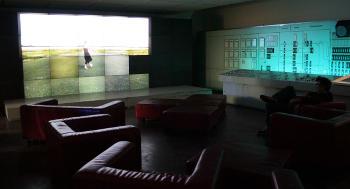
BERLINER LISTE 2016
LOCKED IN – LOCKED OUT. To be human means to be free.
An exhibition by Marie Rolshoven, Jani Pietsch, Florian Voß (Berlin/Germany)
Medienwerkstatt Berlin im Kulturwerk des bbk berlin GmbH
Dear artists and friends of art
We are looking forward to seeing you in the control room of the
Kraftwerk Mitte to our presentation at the art fair Berliner Liste 2016!
this year we have chosen the motto flight | forward.
On the monitor wall in the back of the room we will show screening
programs of the Medienwerkstatt from 2012 -15.
BERLINER LISTE 2016
fair for contemporary art SEP 15-18
Opening: Wednesday, 14. Sept. 18 - 22 h
Kraftwerk Berlin-Mitte,
Köpenicker Str. 70,
10179 Berlin
15. - 17. Sept. 13 - 21 h,
18. Sept. 11 - 19 h
HEIM_SPIEL REINICKENDORF
On 22th Mai 2016 at 2pm

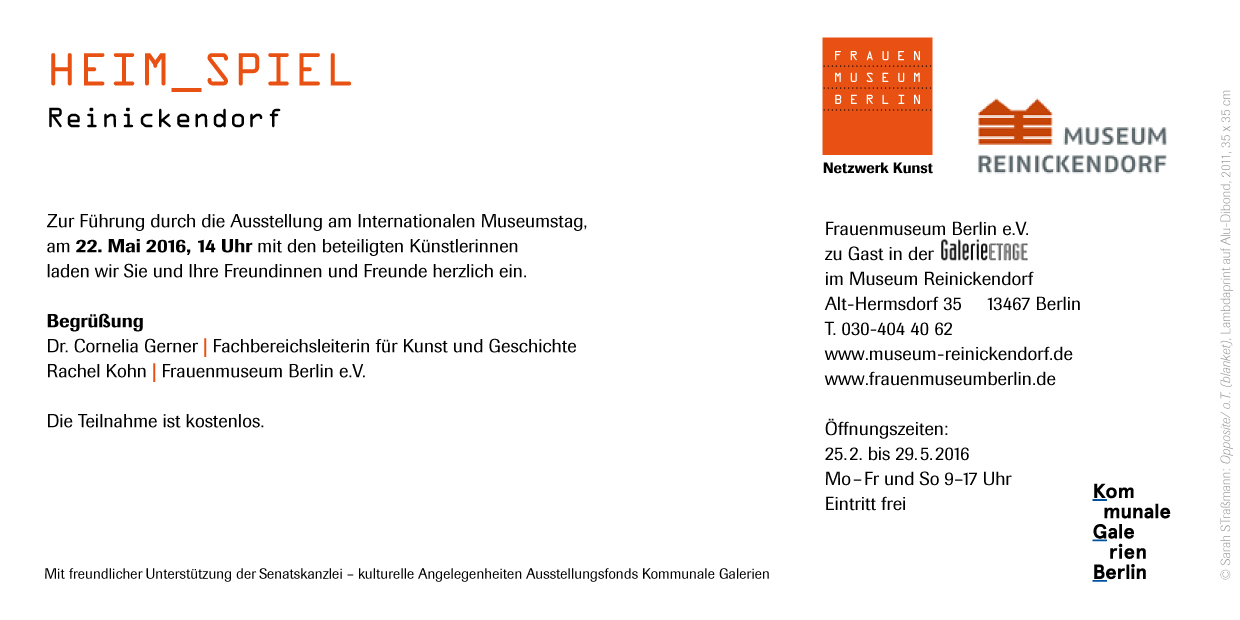
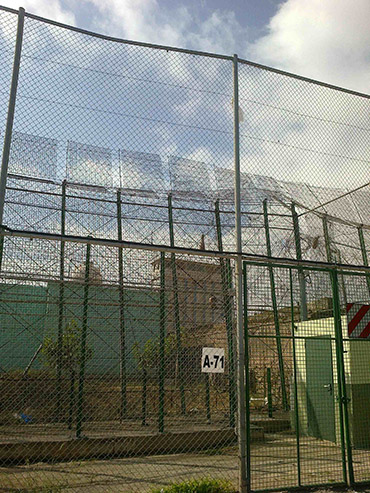
HEIM_SPIEL_REINICKENDORF
LOCKED OUT OF EUROPE
Frauenmuseum Berlin
zu Gast in der GalerieEtage
im Museum Reinickendorf
Alt-Hermsdorf 35
13467 Berlin
25. February 7pm Opening
25. February bis 29. Mai 2016
Monday-Friday, Sunday 9am - 5pm
Admission free
www.museum-reinickendorf.de
www.frauenmuseumberlin.de
LOCKED OUT OF EUROPE
Video Installation | 2014 | 15 min
Pope Francis calls it the globalization of indifference. We are the travellers of
permanent transit, say the refugees.
The European Union is a house with 28 open doors. We Europeans are pleased at
this newly acquired freedom and peace and the possibility of living and working
in whatever area of Europe we choose.
The doors of Europe are locked tight on the outside, especially southwards. Europe’s
furthest southern border is not on European soil but in Africa. Melilla, a Spanish
exclave in Morocco with approx. 80 000 inhabitants, is so far away from Europe and
our peaceful existence that we fail to see what is happening at this, our external
border.
Melilla was fenced in with funds from the European Community. The border system
is eleven kilometres long and consists of three consecutive fences, one of which
is six metres high. Floodlights, movement detectors, thermal cameras,
watchtowers and patrol vehicles are reminiscent of the inner-German border. Very
few attempts to scale the fence succeed. Migrants and refugees from Sub-Saharan
Africa are injured by NATO razor wire or by border guards. Lacerated, they drop
to the ground and, without receiving medical assistance, are frequently deported
back to Morocco on the spot.
Jani Pietsch
explored the
fence on foot
and by bicycle.
Her collage of
video and sound
recordings
translocates
Europe's most
southern border
to the centre of
Europe.
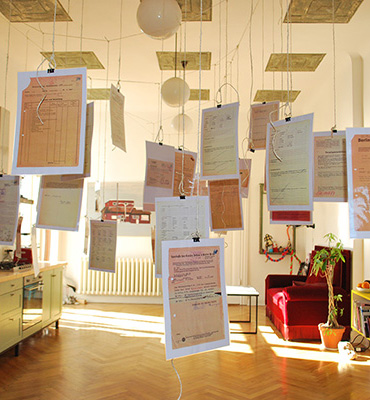
DENK MAL AM ORT
7. / 8. Mai 2016
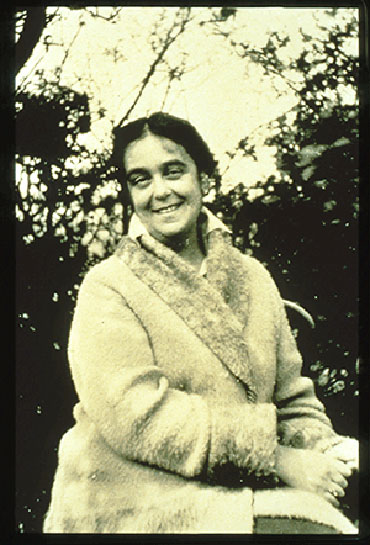
KÄTHE LOEWENTHAL
Exhibition, Film, Reading and Discussion
On view from November 14, 2015 to January 14, 2016 The exhibition features 35 rescued works of painter Käthe Loewenthal.
The Jewish painter Käthe Loewenthal was born in Berlin in 1877 and grew up in Geneva, Lausanne, Paris, Berlin, Bern, and Argentina. Having completed a wide range of artistic studies begun in 1895, she worked as an artist from 1914 until her death, earning her living by painting portraits. In 1933 she was banned from painting and exhibiting. Forced in 1941 to live in a so-called Jewish house, she was placed in a collection point in Weißenstein in 1942. From there she was deported to the Izbica transit camp near Lublin in Poland, where she was murdered.
SCREENING | Saturday | November 14 | 6 pm
The film Käthe Löwenthal (1877-1942)
produced by the Verein Lebenswerk Käthe Loewenthal e.V.
will be shown. A public discussion will be held after
the film in the company of Professor Wolf Ritscher, who
never had the opportunity of meeting his great aunt,
Käthe Loewenthal, personally. The discussion will be
presented by Jani Pietsch.
READING | Sunday | November 15 | 5
pm
Author Jani Pietsch will read the
chapter Karriere geht vor (career has priority) from her
book Ich besaß einen Garten in Schöneiche bei Berlin.
Das verwaltete Verschwinden jüdischer Nachbarn und ihre
schwierige Rückkehr. The chapter deals with the divorce
of Susanne Ritscher, née Loewenthal, and her non-Jewish
husband in the interests of his career. Marie Rolshoven
will present the discussion following the reading, a
conversation between Jani Pietsch and Wolf Ritscher,
Susanne Ritscher-Loewenthal’s grandson.
REGISTRATION: jani.pietsch@gmail.com
Admission to all events is free!
VENUE: Atelier Merseburger Str. 12 10823 Berlin
U7 | Eisenacherstrasse
S1 | Julius-Leber-Brücke
These events are the result of cooperation between Bildungswerk Berlin der Heinrich-Böll-Stiftung and KUBIN and are funded by the Stiftung Klassenlotterie Berlin.
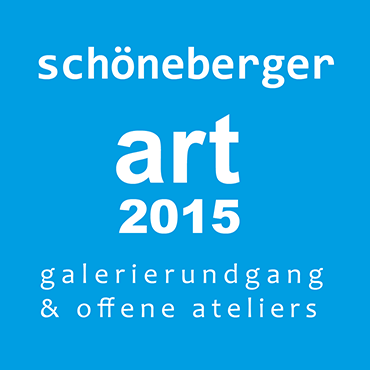
Schöneberger Art 2015
Gallery & Open Artists Studios Event
Saturday | November 7 | 2-8 pm and Sunday | November 8 | 12 am - 6 pm
TWO INSTALLATIONS BY JANI PIETSCH, MARIE ROLSHOVEN + FLORIAN VOSS
An exhibition addresses the fatalities that occurred at the German-German border. Marie Rolshoven and Florian Voß’s light installation focuses on victims of the Berlin Wall.
The past is linked here to the tragic circumstances of today’s refugees at the borders of Europe. Pope Francis calls it the globalization of indifference. We are the travellers of permanent transit, say the refugees.
Jani Pietsch explored the fence between Morocco and the Spanish Exclave Melilla
on foot and by bicycle. Her collage of video and sound recordings translocates
Europe’s most southern border to the centre of Europe.
www.schoeneberger-art.de
